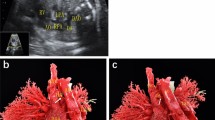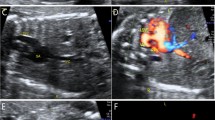Summary
To investigate the application and effectiveness of vascular corrosion technique in preparing fetal cardiovascular cast models, 10 normal fetal heart specimens with other congenital disease (control group) and 18 specimens with severe congenital heart disease (case group) from induced abortions were enrolled in this study from March 2013 to June 2015 in our hospital. Cast models were prepared by injecting casting material into vascular lumen to demonstrate real geometries of fetal cardiovascular system. Casting effectiveness was analyzed in terms of local anatomic structures and different anatomical levels (including overall level, atrioventricular and great vascular system, left-sided and right-sided heart), as well as different trimesters of pregnancy. In our study, all specimens were successfully casted. Casting effectiveness analysis of local anatomic structures showed a mean score from 1.90±1.45 to 3.60±0.52, without significant differences between case and control groups in most local anatomic structures except left ventricle, which had a higher score in control group (P=0.027). Inter-group comparison of casting effectiveness in different anatomical levels showed no significant differences between the two groups. Intra-group comparison also revealed undifferentiated casting effectiveness between atrioventricular and great vascular system, or left-sided and right-sided heart in corresponding group. Third-trimester group had a significantly higher perfusion score in great vascular system than second-trimester group (P=0.046), while the other anatomical levels displayed no such difference. Vascular corrosion technique can be successfully used in fabrication of fetal cardiovascular cast model. It is also a reliable method to demonstrate three-dimensional anatomy of severe congenital heart disease and normal heart in fetus.
Similar content being viewed by others
References
Hoffman JI, Kaplan S. The incidence of congenital heart disease. J Am Coll Cardiol, 2002,39(12):1890–1900
van Velzen CL, Clur SA, Rijlaarsdam M, et al. Prenatal detection of congenital heart disease-results of a national screening programme. BJOG, 2016,123(3):400–407
Clur SA, Van Brussel PM, Ottenkamp J, et al. Prenatal diagnosis of cardiac defects: accuracy and benefit. Prenat Diagn, 2012,32(5):450–455
Hossler F. Vascular corrosion casting. Microscopy Microanalysis, 2003,9(Suppl 2):1578–1579
Liu H, Zhou J, Feng QL, et al. Fetal echocardiography for congenital heart disease diagnosis: a meta-analysis, power analysis and missing data analysis. Eur J Prev Cardiol, 2015,22(12):1531–1547
Lin X, Chen D, Jin Y, et al. Angioarchitecture of extracranial arteriovenous malformations: a vascular casting study. Ann Plast Surg, 2014,73(Suppl 1):S43–48
Ackermann M, Konerding MA. Vascular casting for the study of vascular morphogenesis. Methods Mol Biol, 2015,1214(1214):49–66
Debbaut C, Segers P, Cornillie P, et al. Analyzing the human liver vascular architecture by combining vascular corrosion casting and micro-CT scanning: a feasibility study. J Anat, 2014,224(4):509–517
Lorentziadis M, Chamogeorgakis T, Toumpoulis IK, et al. Topographic anatomy of bronchial arteries in the pig: a corrosion cast study. J Anat, 2005,207(4):427–432
Cook AC, Fagg NL, Allan LD. Use of casts in the necropsy diagnosis of fetal congenital heart disease. Br Heart J, 1992,68(5):481–484
Han W, Xie M, Cheng TO, et al. The vital role the ductus arteriosus plays in the fetal diagnosis of congenital heart disease: Evaluation by fetal echocardiography in combination with an innovative cardiovascular cast technology. Int J Cardiol, 2016,202:90–96
Achiron R, Rotstein Z, Heggesh J, et al. Anomalies of the fetal aortic arch: a novel sonographic approach to in-utero diagnosis. Ultrasound Obstet Gynecol, 2002,20(6):553–557
Kiserud T, Acharya G. The fetal circulation. Prenat Diagn, 2004,24(13):107–112
Torvid K. Physiology of the fetal circulation. Semin Fetal Neonatal Med, 2005,10(10):493–503
Struijk PC, Hanneke M, Mathews JV, et al. Fetal aortic distensibility, compliance and pulse pressure assessment during the second half of pregnancy. Ultrasound Med Biol, 2013,39(11):1966–1975
Reddy PA, Douglas JE, Schulte M, et al. The effect of prefixation on the quality of vascular corrosion casts of rat heart. Cardiovas Pathol, 1995,4(4):133–140
Sims PA, Albrecht RM. Improved tissue corrosion of vascular casts: a quantitative filtration method used to compare tissue corrosion in various concentrations of sodium and potassium hydroxide. Scanning Microsc, 1993,7(2):637–643
Fahrenbach WH, Bacon DR, Morrison JC, et al. Controlled vascular corrosion casting of the rabbit eye. J Electron Microsc Tech, 1988,10(1):15–26
Author information
Authors and Affiliations
Corresponding author
Additional information
The authors contributed equally to this work.
This project was supported by grants from the National Natural Science Foundation of China (No. 81530056 and No. 81501494), Hubei Province Health and Family Planning Scientific Research Project (No. WJ2015MB016), and Hubei Provincial Key Laboratory of Molecular Imaging Foundation, China (No. 02.03.2014-29).
Rights and permissions
About this article
Cite this article
Wang, Y., Cao, Hy., Xie, Mx. et al. Cardiovascular cast model fabrication and casting effectiveness evaluation in fetus with severe congenital heart disease or normal heart. J. Huazhong Univ. Sci. Technol. [Med. Sci.] 36, 259–264 (2016). https://doi.org/10.1007/s11596-016-1577-8
Received:
Revised:
Published:
Issue Date:
DOI: https://doi.org/10.1007/s11596-016-1577-8




